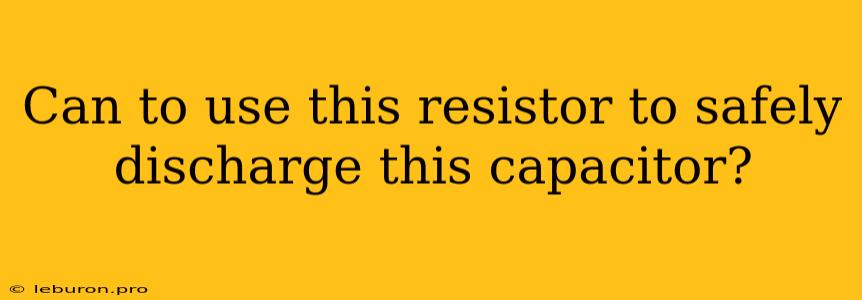Can I Use This Resistor to Safely Discharge This Capacitor?
Capacitors are essential components in many electronic circuits, storing electrical energy and releasing it as needed. However, a charged capacitor can be dangerous if not handled properly, potentially causing electric shock or damage to surrounding components. Therefore, it's crucial to safely discharge a capacitor before working on a circuit or removing it from a device. A common method for discharging capacitors involves using a resistor, but choosing the right resistor is crucial. This article will explore how to determine whether a particular resistor is suitable for safely discharging a capacitor, focusing on the factors that influence this decision.
Understanding the Discharge Process
When a capacitor is connected to a resistor, the capacitor's stored energy begins to flow through the resistor, causing a current. This current gradually reduces the voltage across the capacitor, eventually discharging it completely. The time it takes for the capacitor to discharge is determined by the capacitance (C) of the capacitor and the resistance (R) of the resistor, according to the following formula:
Time Constant (τ) = R x C
The time constant represents the time it takes for the capacitor's voltage to decrease to approximately 37% of its initial value. After five time constants (5τ), the capacitor is considered to be fully discharged for practical purposes, as the voltage drops to less than 1% of its initial value.
Choosing the Right Resistor
The choice of resistor for capacitor discharge depends on several factors, including the capacitor's voltage and capacitance, the desired discharge time, and the power rating of the resistor.
1. Capacitor Voltage and Capacitance
The capacitor's voltage directly impacts the amount of energy stored, and a higher voltage requires a larger resistor to safely handle the discharge current. Similarly, the capacitance value affects the discharge time, with larger capacitors requiring longer discharge times.
2. Discharge Time
The desired discharge time is another important factor. If a quick discharge is necessary, a smaller resistor value can be used, resulting in a faster discharge time. However, a smaller resistor will draw a larger current, potentially overheating and damaging the resistor or other components in the circuit.
3. Power Rating
The power rating of the resistor is crucial to ensure it can handle the energy dissipated during the discharge process. The power dissipated by the resistor is calculated using the following formula:
Power (P) = (Voltage^2) / Resistance
The resistor must be rated for a power value higher than the calculated power dissipation to prevent overheating and failure.
4. Safety Considerations
When choosing a resistor for capacitor discharge, safety is paramount. It's crucial to ensure the resistor can safely handle the discharge current without overheating or failing. Additionally, the resistor should be physically isolated from other components during the discharge process to prevent accidental contact or damage.
Example Calculation: Can I Use This Resistor to Safely Discharge This Capacitor?
Let's consider an example to illustrate how to choose a resistor for capacitor discharge:
Suppose you have a capacitor with a capacitance of 100uF and a voltage of 12V. You want to discharge it using a resistor with a value of 1kΩ.
- Calculate the time constant: τ = R x C = 1kΩ x 100uF = 0.1 seconds.
- Calculate the discharge time: For practical purposes, consider five time constants (5τ), which is 0.5 seconds.
- Calculate the power dissipation: P = (Voltage^2) / Resistance = (12V)^2 / 1kΩ = 0.144 Watts.
Therefore, a 1kΩ resistor can be used to safely discharge a 100uF capacitor charged to 12V. However, ensure the resistor is rated for at least 0.25 Watts (to account for a safety margin).
Conclusion
Choosing the right resistor for capacitor discharge is crucial for ensuring safety and preventing damage to components. By considering factors like the capacitor's voltage and capacitance, the desired discharge time, and the power rating of the resistor, you can select a suitable resistor for safe discharge. Always prioritize safety and ensure the resistor is rated for a power value higher than the calculated dissipation. Never attempt to discharge a capacitor without proper knowledge and precautions, as it can be dangerous.
